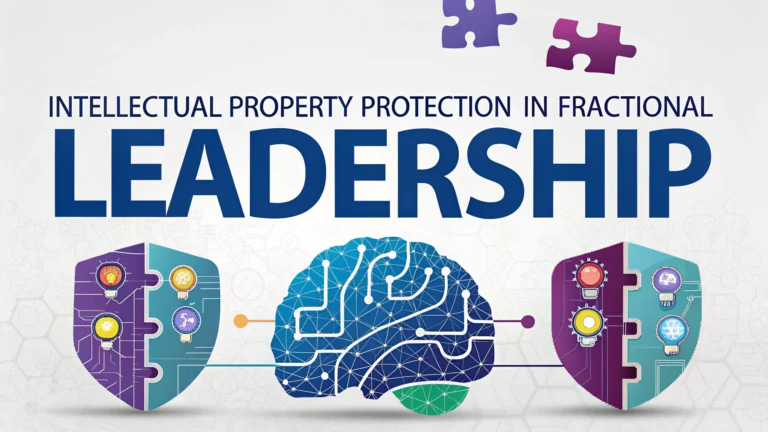Protecting intellectual property (IP) presents unique challenges for fractional leaders who work across multiple organizations.
Fractional COOs and other interim executives must navigate complex legal frameworks while maintaining trust and confidentiality with various clients.
This guide outlines practical strategies for safeguarding intellectual property rights in fractional leadership roles.
Essential IP Protection Measures for Fractional Leaders
- Non-disclosure agreements (NDAs) tailored to fractional roles
- Clear documentation of IP ownership boundaries
- Separate digital storage systems for each client
- Confidentiality clauses in service agreements
Creating Strong Service Agreements
Each client engagement should begin with a detailed service agreement that explicitly addresses IP rights and ownership.
- Define scope of work and deliverables
- Specify ownership of created materials
- Include non-compete provisions if necessary
- Outline conflict resolution procedures
Digital Security Best Practices
Implement robust digital security measures to protect client information:
- Use encrypted cloud storage solutions
- Maintain separate email accounts for different clients
- Enable two-factor authentication on all platforms
- Regular security audits and updates
Managing Client Information Boundaries
| Do | Don’t |
|---|---|
| Use separate devices for different clients | Share information between clients |
| Document all IP-related discussions | Mix client materials in shared folders |
Legal Documentation Requirements
Maintain thorough records of all IP-related matters:
- Signed NDAs and service agreements
- Project documentation and deliverables
- Email correspondence about IP matters
- Meeting notes regarding IP discussions
Conflict Resolution Strategies
Establish clear protocols for handling IP disputes:
- Direct communication channels with stakeholders
- Written documentation of all decisions
- Professional mediation services when needed
- Legal counsel contact information ready
Building Trust Through IP Protection
Strong IP protection enhances client relationships and professional reputation.
- Regular updates on security measures
- Transparent communication about IP policies
- Proactive risk management
Expert Resources and Support
Connect with these professional organizations for additional guidance:
- International Association of Privacy Professionals (IAPP): iapp.org
- World Intellectual Property Organization (WIPO): wipo.int
- American Bar Association IP Law Section: americanbar.org/ip
Moving Forward with Confidence
Regular review and updates of IP protection strategies ensure continued effectiveness and client trust.
Consider working with an IP attorney to review and strengthen your protection measures annually.
Document success stories and lessons learned to continuously improve IP management practices.
Regular Compliance Reviews
Implement systematic review processes to maintain compliance:
- Quarterly audits of IP protection measures
- Annual policy updates and revisions
- Regular staff training on IP protocols
- Documentation of compliance checks
Client Education and Engagement
Training and Awareness
- Provide IP protection guidelines to client teams
- Conduct workshops on security best practices
- Share updated compliance requirements
- Establish reporting procedures for concerns
Communication Protocols
- Regular status updates on IP protection
- Clear escalation procedures
- Documented communication channels
- Feedback mechanisms for improvement
Technology Integration
Leverage modern tools for enhanced IP protection:
- IP management software solutions
- Digital rights management systems
- Automated compliance monitoring
- Secure collaboration platforms
Securing Your IP Protection Legacy
Establish lasting IP protection frameworks that benefit both current and future client relationships. Regular updates to security measures, combined with clear communication and documentation, create a foundation of trust and professionalism in fractional leadership roles.
- Develop comprehensive IP protection playbooks
- Build lasting client relationships through trust
- Create scalable protection systems
- Maintain competitive advantage through security excellence
FAQs
- How can a Fractional COO protect intellectual property when working with multiple companies?
Through strict confidentiality agreements, separate digital workspaces, dedicated devices for each client, and clear documentation of IP ownership in service contracts. - What legal documents should be in place to protect intellectual property in fractional leadership arrangements?
Non-disclosure agreements (NDAs), non-compete clauses, IP assignment agreements, and detailed service contracts specifying ownership of work products and innovations. - Can a Fractional COO use strategies or processes developed for one client with another client?
Generic business processes and industry-standard practices can be used, but client-specific innovations, proprietary methods, and unique solutions must remain exclusive to the original client. - How should sensitive company information be handled in a fractional leadership role?
Through encrypted communication channels, secured cloud storage, restricted access protocols, and careful segregation of client data in separate digital environments. - What are the potential IP risks when a Fractional COO works in the same industry for different clients?
Risks include inadvertent disclosure of trade secrets, cross-pollination of proprietary information, and potential conflicts in patent or trademark development. - How can companies ensure their trade secrets remain protected when working with a Fractional COO?
By implementing information classification systems, limiting access to sensitive data, requiring regular compliance reports, and establishing clear protocols for information handling. - What role does cybersecurity play in protecting IP for Fractional COOs?
Cybersecurity is crucial, requiring secure VPNs, multi-factor authentication, encrypted devices, and regular security audits to protect client intellectual property. - Are there specific insurance requirements for protecting IP in fractional leadership roles?
Professional liability insurance, cyber insurance, and errors and omissions (E&O) coverage are essential to protect against IP-related claims and breaches. - How should a Fractional COO handle IP developed during their engagement?
Through clear contractual terms defining IP ownership, documentation of innovation processes, and immediate assignment of rights to the client company. - What exit protocols should be in place to protect IP when a fractional leadership engagement ends?
Data return or destruction procedures, final IP assignments, confirmation of confidentiality obligations, and removal of access to company systems and information.







